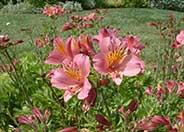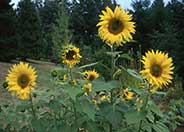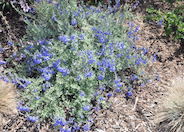
Common name:Peruvian Lily, Alstroemeria
Botanical name:Alstroemeria hybrids
The deciduous rhizomes of this Peruvian Lily will often run aggressively if not controlled. They grow best in full to partial sun with some summer watering in dry climates. The florist strains can reach 6' tall, while the compact strains range from 12" 36" tall. For extra long, florist quality stems, stake or grow through netting for support.

Common name:Sweet Orange cultivars
Botanical name:Citrus sinensis
This tree will grow 20'-30' high and 10'-15' wide; it produces sweet, tasty oranges. It has shiny green, leathery foliage and produces clusters of fragrant white flowers that bloom in the spring.

Common name:Sunflower
Botanical name:Helianthus annuus
Sunflowers can grow anywhere from 6'-15' tall on top of thick, sturdy stems. They have large, dark green leaves with bright yellow flowers with tender petals that bloom spring to summer. The flowers need direct sunlight and a lot of water.

Common name:Germander Sage
Botanical name:Salvia chamaedryoides
This low mounding perennial with a long bloom period, spreads by underground runners. It produces a small, silvery foliage which serves as a background for bright blue flowers. Bruised leaves have a spicy fragrance. Germander Sage reaches 2' tall and wide. Heaviest blooms are in spring and early fall, but intermittent throughout the year. It requires full sun, well draining soil and is drought tolerant once it's established. Do not fertilize.

Common name:Climbing Rose
Botanical name:Rosa Climbing varieties
With its dark green foliage and fragrant flowers with full and double blooms, this upright shrub is generally grown as a vine or pillar rose. Climbing varieties come in many colors.

Common name:Prostrate or Spreading Acacia
Botanical name:Acacia redolens 'Prostrata'
This is a fast growing, drought tolerant ground cover growing no higher than 3' and spreading 12 to 15' wide. The leaves are gray green; it has yellow flowers from February to April.
Designer: Annie Hall
Photographer: GardenSoft
Incorporate compost 6" into your soil to retain water, reduce compaction, feed earthworms, and provide valuable nutrients to your plants.
Remove irrigation water and fertilizer from areas where you don't want weeds to grow.